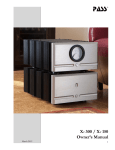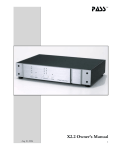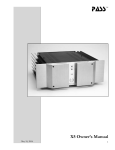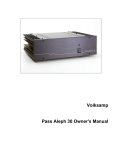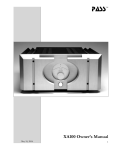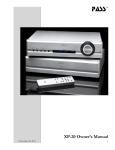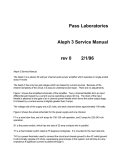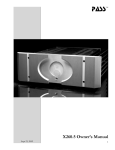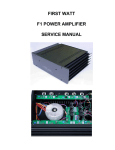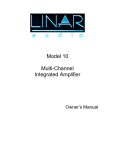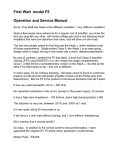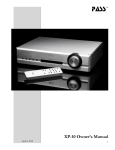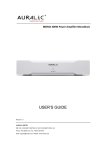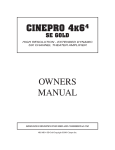Download Pass Labs XP-30 User's Manual
Transcript
pass TM XP-30 Owner’s Manual November 25, 2011 XP-30 Owner’s Manual 1 Introduction In an area of electronics where it is often thought that everything that can improve the sound has already been done, where other designers are concentrating on mechanicals and eye-candy, we offer better sound. The XP-30 is the best preamplifier line stage ever made by Pass Labs. By extension it is possibly the best line stage ever made. It is the result of several years effort by Wayne Colburn and staff at Pass Labs and has undergone numerous designs, redesigns, revisions, more revisions, adjustments and tweaks; more than any preamp product with the possible exception of the XP-25 phono stage. Measurably the XP-30 generates less noise, less crosstalk, less distortion. It delivers greater dynamic range, gain, output voltage and output current. This is not why it is a breakthrough product. We value technical excellence, but it is always the sound that is paramount. Many audio products have measured spectacularly well but have not gone down as classics because they have not delivered subjective qualities that keep listeners happy beyond the occasional initial excitement. With this uppermost in mind we set out to create a new preamplifier that simply invites you to listen. We want you to anticipate listening to your entire record collection, again and again. As part of the process in developing the XP-30 we began by uniformly upgrading the playback systems of our listening group. We do not do AB or ABX testing – our people live with prototypes as long as they like in their own system, and only one component gets changed at a time. This allows a close duplication of our customer’s experience and makes it easier to hear differences over extended time, with our focus remaining on the quality of the sound. Several set of prototypes were evaluated and refined over a period of three years. This period also saw the final development of the XP25, and its presence allowed us to work in as much synergy between the components as possible. Several different power amplifiers also participated, including XA.5 amplifiers, prototype “Concept” amplifiers, SITs, and even tubes. In the end everyone agreed on the sound - music flows through the XP-30 with greater ease, spatial development and dynamic contrast than anything else we have heard. Wayne even managed to fit in a couple of my requested features – enhancements for bi-amping, and enough gain and voltage swing that the XP-30 can drive power amplifier output stages all by itself. Me, I wrote this introduction because Wayne was too modest to. - Nelson Pass XP-30 Owner’s Manual 2 Description The XP-30 is a modular preamplifier consisting of one control / power supply chassis and additional gain chassis, each containing the analog circuits of a single channel. The XP-30 is meant to typically be used as a two-channel product, but you can use the control chassis to serve up to six channels. Each channel individually provides master and slave outputs. The relative level between the master and slave outputs of each channel is adjustable by a knob on the front panel of each individual gain chassis. If you have ever wanted to bi-amp your loudspeakers, you might appreciate that this feature allows easy use of different types of amplifiers for the low vs the high frequencies, adjusting the relative levels as needed. If you need big power and control on the bottom but want the sweet character of tubes on the top, you may wonder how you ever got along without this. Or why other companies don’t offer it. It is even useful when the same types of amplifiers are used – typically without the full load on each amplifier the subjective balance still needs minor tweaking. All connected gain chassis respond to the master level adjustment on the main control chassis through a completely new volume control covering a range of 100 dB in precise 1 dB steps. Both outputs of each channel are offered as single-ended and balanced outputs having the same gain and impedance and both may be used simultaneously with no degradation. There are five (5) regular inputs, a special home theater bypass input and tape input for those needing any side loops for recording or signal processing. The control chassis also supports a mono function between the separate different analog stage chassis. The power supply in the control chassis is large enough for somebody else’s power amplifier. It contains a pair of highly efficient, low-noise Plitron transformers in dual mono topologies, emi filtering, large capacitance reservoirs, and of course the isolation that comes with being in a different chassis from the analog gain stages. Something else that was on Nelson’s wish list – the ability to drive an amplifier output stage by itself: Do you require a preamplifier deliver a fraction of a volt to the power amplifier or peaks in excess of 50 XP-30 Owner’s Manual 3 volts to a balanced no-feedback follower output stage? The XP-30 is fully capable of both tasks at once. The internal gain of each stage can be boosted another 16 dB via an internal jumper and the preamp can serve as the low source impedance front end to the new generation of Class A power followers. Don’t laugh – they already are for sale, and there are more coming your way. If you have an XP-30 you won’t have to buy a new preamp... The output impedance of each output is quite low and thus able to better drive long cable runs or cables with greater capacitance or amplifiers with low input impedances. XP-30 volume control is totally new and sonically unique. It’s measured performance - distortion, bandwidth, noise, and resolution is beyond reproach. It preserves the dynamics and detail of the music passing through it, and scales this performance over its 100 dB attenuation range. Wayne Colburn has further refined his thinking of how the active circuit should serve the music. Like Nelson, Wayne looks at parts and sees not applications but potentials. The XP-30 uses a new and more advanced version of the gain modules that have been popular in Pass products for the last ten years. It has lower distortion and wider bandwidth than its predecessor and also features a dramatically higher input impedance. This improved version of our symmetric topology sounds so exquisite that that it has also been adopted in the new “Dual Chassis Amplifier” prototypes. Pass Labs has made large purchases of discontinued Toshiba Jfets and Mosfets to support production of this new gain stage for the next ten years. Each of these efforts have contributed to a preamp that is more resolving, dynamic, spatially accurate and closer to the real joy that is music. To summarize: The XP-30 is a time machine, offering a greater “look-back” at the original musical performance and conveying additional insight to the artist’s creative intent. The XP-30 will help you rediscover the joy of your record collection. It’s measured performance is our best yet. It has some features that will help you get more out of your system – things that you may not yet appreciate. The XP-30 is the preamplifier that we built for ourselves. XP-30 Owner’s Manual 4 Set-up Setup and Operation So much for self-congratulation. Lets play some music! On a more sober note, please read and understand the operational instructions and safety issues associated with this product. All of us at Pass Laboratories put great effort into building a soundly engineered and superbly performing rugged product of lasting durability and value. We understand that things occasionally go wrong, but we are here to support you if that happens. If you have any questions or problems, please contact either your dealer or the factory. The support email address is: [email protected] If you don’t get a good enough answer, you can appeal to [email protected] or even [email protected] It is usually helpful to have your product’s serial number available when you contact the factory. It is by serial number that we track all hardware and software details and history of an individual product unit. Power Connection As with all audio electronics the power cable should be the last thing attached and the first one removed any time you hook up or remove equipment from the signal chain. First The preamplifier’s voltage and current ratings are indicated by affixed tag on the rear of the preamplifier’s power supply / control module. The tag will indicate 240 volts, 220 volts, 120 volts or 100 volts. A 2.0 amp 3AG slow blow fuse is provided with stereo 100 –120 volt units and a 1.0 amp 3AG slow blow fuse is provided with stereo 220 – 240 volt units. XP-30 Owner’s Manual 5 Additional channels beyond the normal two may require a different fuse value, please contact the factory for your specific application. The input frequency rating of the power-supply is presumed 5060 Hz in all instances. Some individuals may wish to use a power regeneration apparatus, and slightly higher lines frequency is presumed acceptable. The preamplifier typically draws 45 watts of power from the utility mains during operation as a 2 channel preamplifier. Additional channel demands increase the demand for line wattage by approximately 15 watts per channel. We have provided a high quality standard IEC AC power cord that fits into the IEC 320 line receptacle at the rear of the power supply / control chassis. This is the power cord we use for all product evaluation. You may substitute an equivalent “after market” power cord of your choosing; however, we strongly suggest that any cord you select must carry all appropriate government certifications for your location. Under no circumstances defeat the safety ground provided by the power cord. We have provided internal isolation to help prevent ground loops. If ground loops exist in your system which suggest to you that you might want to disconnect this earth ground, please contact your dealer or the factory first. Be aware that some of the internal noise filters of this product presume a good earth ground through the power cord. Removing that ground may compromise system performance. Do not plug in the power cord yet. Second Place the components that comprise the XP-30 in the locations where you plan to use them. They don’t need a lot of ventilation, but a little is helpful. On the rear of each control chassis are two identical DIN-25 sockets in parallel with one another. You may connect either socket to the control chassis, as previously indicated they are identical. The second socket provides daisy chain capability for additional gain channels. The DIN-25 connecting cables only communicate power, and control commands to the gain stages. At no time does audio signal cross the DIN-25 umbilical cables. Keeping each gain channel chassis 100% isolated from every other gain channel chassis reduces channel cross-talk to a near theoretical minimum. XP-30 Owner’s Manual 6 Connect the power supply / control chassis to the gain stages by the supplied DIN-25 umbilical cables. They must be pressed firmly into the receptacles, keeping in mind that the connector shell is trapezoidal, which keys the proper orientation. Finger tighten the screws on either side of the connector shell. Do not use excessive force, take care not to cross thread the screws. Third There are a total of seven inputs on each chassis. The first inputs are numbered 1-5. Input 6 has been named “Pass-Thru” and is intended for use with a home theater processor (see the later notes on use of input 6). Input 7 is the tape loop. The XP-30 is shipped with shorting plugs on the input XLR connectors which connection the (-) pin 3 input to the ground pin 1 input. Save these jumpers. They are not only gold plated and thus valuable, but you will need them when you wish to operate an input with RCA (single-ended) connections. The XLR pins are numbered, but you’ll have to look close, maybe with a hand lens. There are two sets of balanced and single ended outputs on each channel, designated “master” and “slave”. You may connect and use as many of these outputs as you wish without degradation of signal. Each output is derived from it’s own circuit element and is totally independent of any other outlet. On the XLR, pin 1 is ground, pin 2 is positive and pin 3 is negative. The XP-30 also incorporates a “tape-loop” for those users who either record or wish to insert a processor loop as a side chain. Tape out communicates directly back to the input bus, bypassing the volume control. Tape out is always active, with one exception, where Tape Out is isolated from Tape Input to avoid a feedback loop. The tape loop is only available from the remote control and is selected or deselected by a single keystroke of the “Tape” button on the hand remote. When tape is selected from the hand remote, the display on the power supply shows a lower case “t” on the right hand side of the display. When the letter “t” is showing, the tape input is “selected” and all other inputs are “deselected”, regardless of any previous settings you may have chosen. Pressing the “Tape” button a second time, cancels the command. XP-30 Owner’s Manual 7 Handy Features The home theater “Pass-thru” command is simply a software setting that selects input 6 and sets the gain to 0 dB with a minimum of keystrokes. The keystroke shortcut selects input 6 and slowly advances the volume control to step 89, starting from 0. The slow advance of level is intentional; 0dB (step 89) is appropriate for a home theater processor, it is however dangerously high for most source components. As the level advances the display will indicate each volume step with the step number and the suffix L & R (Left and Right). Once the 0dB point is reached the L & R suffix are superceded with a letter P (Pass-Thru). At any time the volume advance for the Home Theater Bypass may be interrupted by pressing any button on the hand remote other than the Pass-Thru button. Once halted the volume may be manually set from either the front panel volume control or from the volume up ^ and volume down v arrows on the remote. Pass- Thru functionality may be over ridden allowing this input to be treated as simply as an additional user addressable input. The slow advance of level allows the user to safely cancel the incremented volume increase command and assert manual control over the preamplifier output level. When selected as an additional input the control chassis display will show this selection as input 6 with the letters L (left) and R (right) as suffix’s to the level setting. The XP-30 has a single pair of binding posts on the power-supply / control chassis which are labeled “Ext. Amp Turn-on”. A 12-volt DC signal is available at these binding posts to control additional entertainment electronics. The External Turn-on feature was specifically intended to control Pass Laboratories power amplifiers, but may in fact control items from other makers with similar features. The binding post red terminal conveys a 12-volt positive voltage and the binding post black terminal is a ground reference voltage. Please check the owners manuals of your ancillary equipment for particulars of compatibility. If you have a question, please contact the Pass Laboratories factory. Specific to Pass Laboratories power amplifiers is the requirement that the power amplifier be placed in standby from it’s front panel control before using the remote turn on function. The power amplifier’s onboard stand-by switch over rides the pre amplifier control with respect to the “on” command. This is intentional so that the power amplifiers may also be controlled manually. XP-30 Owner’s Manual 8 The monaural function is selected only from the front panel, it is not available from the hand remote. When mono is selected, rather than creating a true mono signal it creates a frequency dependent blend of signal from two chassis. The blend has been chosen such that it minimizes noise while maximizing information transfer. The two blended gain chassis are joined to one another by a special XLR cable The blend function was intended to address the special needs of professional audio archivists who frequently work with recordings of historical importance and dubious quality. These professional archivists require circuits that transfer the last iota of intelligible detail combined with the smallest percentage of unwanted artifact (spurious noise). The blend circuit specifically addresses this professional need. As a casual listener you may find the “mono” function of value when listening to any recordings that presumed a single point source reproduction rather than two-channel. The high frequency blend of the mono control frequently reveals performance nuances in these recordings that would otherwise go unnoticed on a two-channel system. If you have any questions whatsoever about product safety, please contact your dealer, distributor, or Pass Labs by email: [email protected] XP-30 Owner’s Manual 9 “Pass”, “pass”, “Pass Labs”, “Pass Laboratories”, Supersymmetery”, “Aleph”, and “Zen” and are all registered trademarks of Pass Laboratories, Inc., and all rights thereto are protected by law. XP-30 Owner’s Manual 10 For your protection please read the following: Water and moisture: Electrical devices should not be used near water ( as per example, near a bathtub, washbasin, kitchen sink, laundry tub, wet basement or swimming pool ). Care should be taken such that objects do not have the opportunity to fall, and that liquid is never spilled onto or into the device enclosure through openings. Power Sources: An electrical device must be connected to a mains power source in strict accordance with the supplied product owner’s manual. Please verify that the AC mains voltage specified in the product manual matches those requirements indicated on the unit and the AC voltage provided to your location by the power company. Grounding: Adequate precautions should be taken so that the grounding provisions built into an electrical product are never defeated. Power Cords: Pass Laboratories provides a power supply cord that meets all legislated requirements for the market in which the product was originally sold. If you choose to substitute an after-market product we urge you to choose one that is fully safety rated by the necessary local authority. Power Cord Protection: Power supply cords should be routed so that they are not likely to be walked on, abraded, or pinched by items placed on or against them, paying particular attention to cords where they enter plugs or exit from a device. Never under any circumstance insert a cut or damaged power cord into a mains power socket. Power and Signal: Cables should never be connected / disconnected with equipment powered up. Failure to heed this warning may damage or destroy equipment. Ventilation: Power-amplifiers run hot, but you should be able to place your hands on them without discomfort. You must allow for this heat in installation, by providing for free air circulation around the product. Electronics should not be subjected to sources of excessive radiant heat. Excessive heat can shorten the life of the product and may cause the electronics to self-protect and shut down. Servicing: To reduce the risk of fire, electrical shock or other injuries, the user should not attempt to service the device beyond that which is described in the operating instructions. All other servicing must be referred to qualified service personnel. XP-30 Owner’s Manual 11 Pass Labs Warranty All Pass Laboratories products purchased new from an authorized Pass Laboratories dealer in North America are covered by a transferable, limited 3-year warranty. This warranty includes all parts and labor charges incurred at the factory or factory specified repair facility, exclusive of any subsequent or consequential damages. Damage due to physical abuse is specifically excluded under this warranty. For this warranty to apply the customer is responsible for returning the product unmodified to the factory within the specified warranty period. The customer assumes all responsibility for shipping and insurance to and from the factory or a factory specified repair facility. The conditions and stipulations of this Pass Laboratories warranty only applies to units originally sold new through an authorized dealer. Warranty on factory repair is 60 days and covers only the scope of the original repair. Non-North America customers should consult with their original Pass Labs dealer or distributor for warranty repair instruction prior to contacting the factory or shipping product to the factory for repair. Non-North American product must be returned to the country of origin for warranty service. Foreign distributors are only required to offer warranty service on Pass Laboratories product that they have imported, verifiable by serial number. Please note: Conditions of warranty service and customer rights for product purchased outside the United States may vary depending upon the distributor and local laws. Please check with your local distributor for specific rights and details. Any modifications to Pass Laboratories products that have not received written factory approval nullify all claims and void all provisions of the warranty and liability by the maker or authorized distributor. Should a modified product be returned to the factory for repair the owner will be required to pay all necessary charges for the repair in addition to those charges required to return the product to it’s original configuration. In the case of safety issues, no product shall be returned to the customer without those safety issues being corrected to the most recent accepted standards. Removal or alteration of original Pass Labs serial numbers voids the factory warranty. Product with altered or missing serial numbers will be suspect as counterfeit or stolen product. Pass Laboratories will not repair or in any way indemnify any counterfeit or cloned product. Pass Laboratories does not offer products in voltages intended for international markets either to authorized Pass Labs dealers or to third parties located in the United States or Canada. For more information please contact: Pass Laboratories Inc. XP-30 Owner’s Manual 12 pass® Pass Laboratories Inc. PO Box 219, Foresthill, CA 95631 voice: 530.367.3690 - fax: 530-367-2193 - web: passlabs.com XP-30 Owner’s Manual 13













